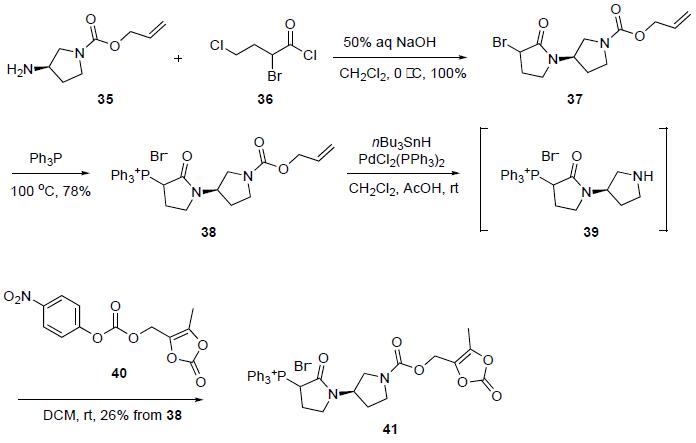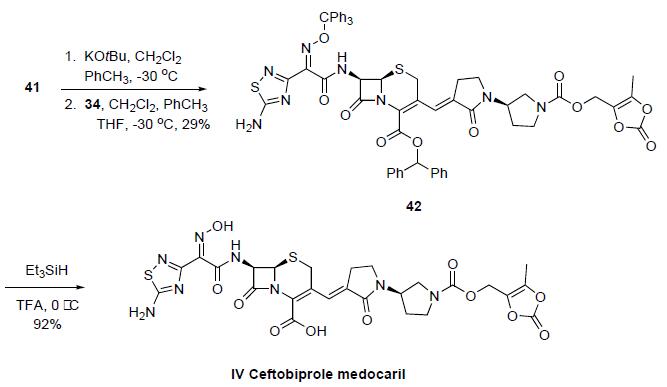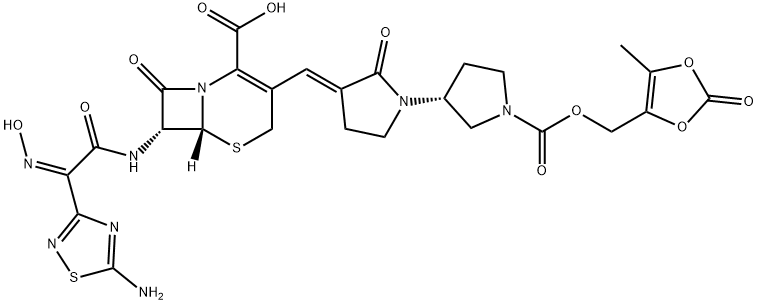Ceftobiprole medocaril is a new injectable cephalosporin antibiotic
with broad-spectrum activity against a wide range of difficult-to-treat
Gram-positive and Gram-negative hospital- and community-acquired
infections including MRSA. It was launched in Canada for the treatment of cSSSI, including diabetic foot infection. Ceftobiprole
medocaril is a water-soluble pro-drug of ceftobiprole, which is a
pyrrolidinone-3-ylidenemethyl cephem with a 3-pyrrolidinyl side chain.
The pro-drug is derived by the attachment of a carbamoyl ester group on
the pyrrolidine nitrogen of ceftobiprole. Like all beta-lactam antibiotics,
ceftobiprole produces its bactericidal effects by inhibiting cell wall synthesis through the prevention of the cross-linking of peptides on the
mucosaccharide chains that make up the cell wall. This is accomplished
by binding to and inhibiting the penicillin-binding proteins (PBPs). As
a result, bacterial cell walls are weakened and susceptible to osmotic
pressure and cell lysis. The broad-spectrum activity of ceftobiprole is due
to the inhibition of PBPs in both Gram-positive and Gram-negative
bacteria. In addition, ceftobiprole inhibits PBP2x in penicillin-resistant Streptococcus pneumoniae as well as PBP3 and other PBPs in certain Gram-negative bacteria such as Escherichia coli and Pseudomonas aeruginosa.Among Gram-positive pathogens, it has excellent activity against coagulase-negative staphylococci (both methicillin-susceptible and methicillin-resistant strains), S. pneumoniae (including penicillinresistant strains) and other streptococcal species, and Enterococcus faecalis (MIC90 4 mg/mL).Ceftobiprole is also active in vitro against a broad range of aerobic Gram-negative bacilli, including P. aeruginosa, against which its activity is similar to that of cefepime.
The synthesis of ceftobiprole and
ceftobiprole medocaril have been reported in several patents
and the synthesis of the prodrug will be highlighted as shown
in Schemes 4.1-4.3. Activation of the amino dithiazole
acid salt 26 with benzothiazole disulfide 27 via
diethyl phosphite gave thioester 28 in 82% yield. Condensation
of 28 with aminocephalosporin 29 using tetramethyl
guanidine (30) as the base in DMF at 0 °C provided intermediate
acid 31, which was then immediately
esterified by reaction with diphenyl diazomethane at 0 °C to
give diphenylemethyl ester 33 in 91% yield. Alcohol 33 was
then oxidized with sodium hypochlorite in the presence of
TEMPO to give the desired aldehyde 34 in 74% yield, which
was ready to be coupled to the phosphonium salt 41.

The preparation of phosphonate 41 is described in
Scheme 4.2 and was initiated by the reaction of amino pyrrolidine
35 with acid chloride 36 with 50% sodium hydroxide
in DCM to provide the amidopyrrolidine 37 in quantitative
yield. Bromide 37 was then treated with triphenylphosphine
to give phosphonate 38 in 78% yield. Removal of
the allyl carbonate protecting group was accomplished through reaction with tributyltin hydride with palladium catalysis
to afford bipyrrolidine 39, which was then treated
with the carbonate 40 to give phosphonium salt 41 in 26%
yield, which was now activated for Wittig condensation with
aldehyde 34.
The completion of the preparation of ceftobiprole medocaril
is described in the scheme. Phosphonate 41 was deprotonated
with potassium t-butoxide to generate the corresponding
ylide that was subsequently reacted with the cephalosporin
aldehyde 34 to produce the olefinic betalactam ester
42 in 29% yield. Removal of the diphenylmethyl ester and
trityl groups were accomplished by reaction with triethylsilane
in the presence of TFA completing the synthesis of
ceftobiprole medocaril (IV) in 92% yield.< style="text-align: center;">


